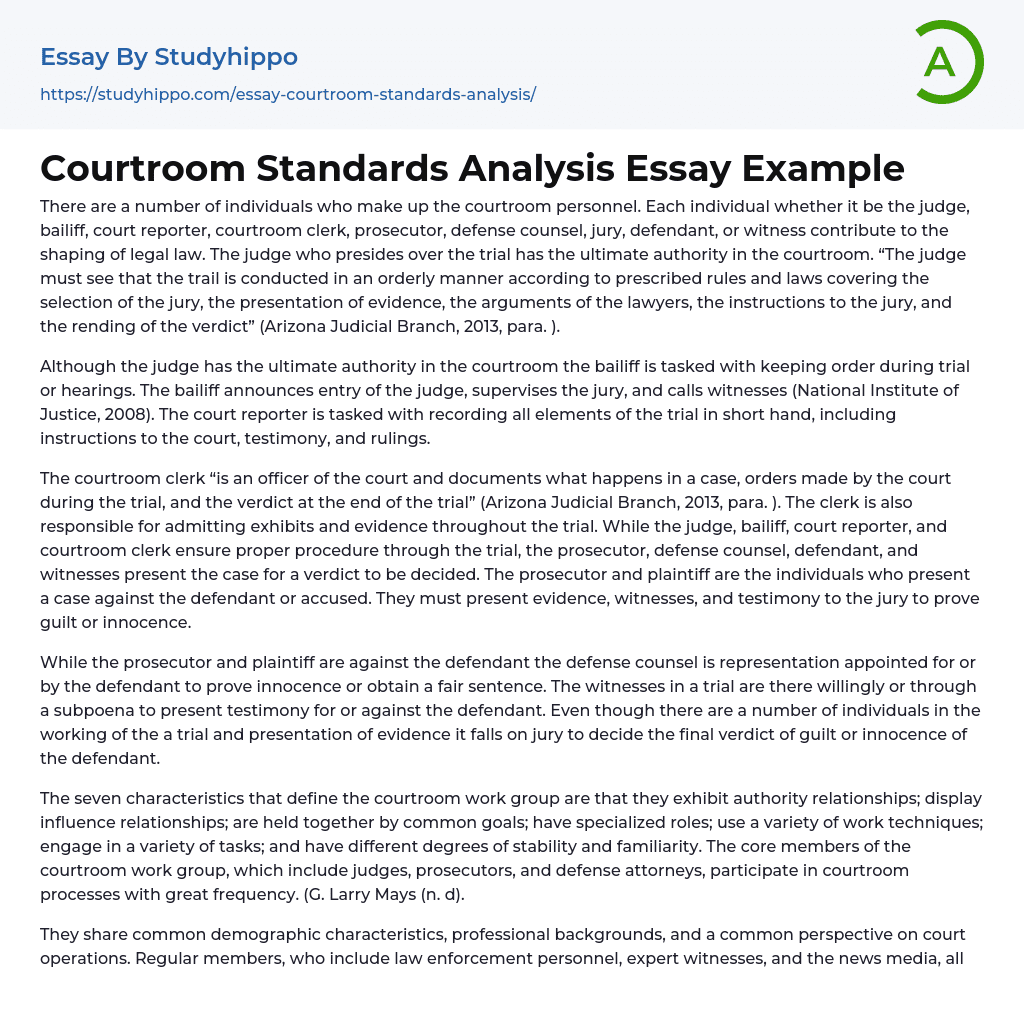The courtroom personnel comprises of different individuals, such as the judge, bailiff, court reporter, courtroom clerk, prosecutor, defense counsel, jury, defendant, and witness. Each person contributes to the development of legal law. The judge holds the highest authority in the courtroom and is tasked with maintaining order during the trial by following established rules and laws. This involves supervising the jury selection process, presenting evidence, listening to lawyers' arguments, giving instructions to the jury, and delivering a verdict (Arizona Judicial Branch 2013).
In the courtroom, the judge holds ultimate authority, while the bailiff is responsible for maintaining order during trial or hearings. The bailiff announces the judge's entry, oversees the jury, and summons witnesses (National Institute of Justice, 2008). On the other hand, the court reporter records all aspects of the trial in shorthand, such as court
...instructions, testimonies, and rulings.
The courtroom clerk's main responsibility is to document the entire case, including court orders and the final decision. They also oversee the submission of evidence and exhibits during the trial. Collaborating with the judge, bailiff, and court reporter, the courtroom clerk ensures that proper protocols are adhered to throughout the proceedings.
In a trial, the prosecutor and plaintiff oppose the defendant while the defense counsel, appointed on behalf of the defendant, aims to prove innocence or obtain a fair sentence. Witnesses can willingly testify or do so under subpoena to present evidence that either supports or contradicts the defendant's case. Although multiple individuals participate in presenting evidence during the trial, it is ultimately the jury's responsibility to determine guilt or innocence.
The courtroom work group, consisting of judges,
prosecutors, and defense attorneys, is characterized by seven key features: authority and influence relationships, common goals, specialized roles, a variety of work techniques and tasks, as well as varying degrees of stability and familiarity (G. Larry Mays (n. d).
The court has regular members, such as law enforcement personnel, expert witnesses, and the news media. These members frequently participate in courtroom activities but have less involvement compared to the core group members. On the other hand, occasional participants like jurors, crime victims, and litigants are only involved infrequently or once in the court process. This group has diverse training, values, and orientations (Mays, n.d).
The courtroom work group comprises various authority relationships. Judges have the highest authority in the court, which is evident through their attire, the courtroom design, and how they are addressed. However, the judge's authority is limited by factors like the prosecutor's discretion, control over finances, jurisdiction, sentencing guidelines, and potential appeals. All members of the work group influence each other and are influenced by others. Moreover, each member has distinct sources of power and areas of expertise. Judges have formal authority to direct court actions and attorneys.
Both prosecutors and defense attorneys possess different knowledge and powers in the legal system. Prosecutors have better case knowledge and the authority to decide which matters will be taken to trial. On the other hand, defense attorneys have the ability to interview witnesses, gather evidence through discovery, and file pretrial motions. The primary goals shared by both parties are to achieve justice, maintain group cohesion, handle the case load efficiently, and reduce uncertainty. The diverse knowledge bases
within the group result in members having different forms of power and influence. The three common interaction techniques employed are unilateral decisions, adversarial proceedings, and negotiations.
- Walls essays
- Agreement essays
- Business Law essays
- Common Law essays
- Community Policing essays
- Constitution essays
- Consumer Protection essays
- Contract essays
- Contract Law essays
- Copyright Infringement essays
- Court essays
- Crime essays
- Criminal Law essays
- Employment Law essays
- Family Law essays
- Injustice essays
- Judge essays
- Jury essays
- Justice essays
- Lawsuit essays
- Lawyer essays
- Marijuana Legalization essays
- Ownership essays
- Police essays
- Property essays
- Protection essays
- Security essays
- Tort Law essays
- Treaty essays
- United States Constitution essays
- War on Drugs essays
- Adoption essays
- Aunt essays
- Babies essays
- Bedroom essays
- Caring essays
- Children essays
- Daughter essays
- Divorce essays
- Dog essays
- Dysfunctional Family essays
- Family Tradition essays
- Family Values essays
- Father essays
- Foster Care essays
- Friends essays
- Grandparent essays
- Home essays
- Hometown essays
- Husband essays




